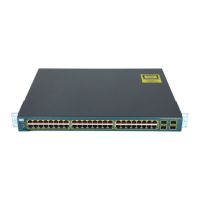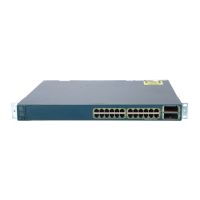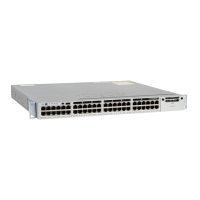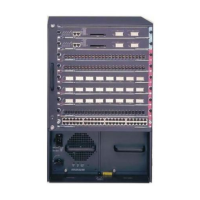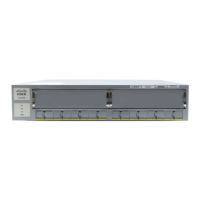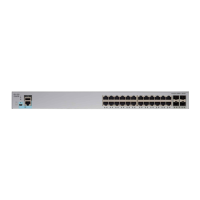1-8
Catalyst 3750 Switch Software Configuration Guide
78-16180-02
Chapter 1 Overview
Features
–
Trusted port states (CoS, DSCP, and IP precedence) within a QoS domain and with a port
bordering another QoS domain
–
Trusted boundary for detecting the presence of a Cisco IP phone, trusting the CoS value
received, and ensuring port security
• Policing
–
Traffic-policing policies on the switch port for managing how much of the port bandwidth
should be allocated to a specific traffic flow
–
Aggregate policing for policing traffic flows in aggregate to restrict specific applications or
traffic flows to metered, predefined rates
• Out-of-Profile
–
Out-of-profile markdown for packets that exceed bandwidth utilization limits
• Ingress queueing and scheduling
–
Two configurable ingress queues for user traffic (one queue can be the priority queue)
–
Weighted tail drop (WTD) as the congestion-avoidance mechanism for managing the queue
lengths and providing drop precedences for different traffic classifications
–
Shaped round robin (SRR) as the scheduling service for specifying the rate at which packets are
dequeued to the stack ring (sharing is the only supported mode on ingress queues)
• Egress queues and scheduling
–
Four egress queues per port
–
WTD as the congestion-avoidance mechanism for managing the queue lengths and providing
drop precedences for different traffic classifications
–
SRR as the scheduling service for specifying the rate at which packets are dequeued to the
egress interface (shaping or sharing is supported on egress queues). Shaped egress queues are
guaranteed but limited to using a share of port bandwidth. Shared egress queues are also
guaranteed a configured share of bandwidth, but can use more than the guarantee if other queues
become empty and do not use their share of the bandwidth.
Layer 3 Features
Note Some features noted in this section are available only on the EMI.
• HSRP for Layer 3 router redundancy
• IP routing protocols for load balancing and for constructing scalable, routed backbones:
–
RIP versions 1 and 2
–
OSPF (requires the EMI)
–
Interior Gateway Routing Protocol (IGRP) and Enhanced IGRP (EIGRP) (requires the EMI)
–
Border Gateway Protocol (BGP) Version 4 (requires the EMI)
• IP routing between VLANs (inter-VLAN routing) for full Layer 3 routing between two or more
VLANs, allowing each VLAN to maintain its own autonomous data-link domain
• Policy-based routing (PBR) for configuring defined policies for traffic flows
• Fallback bridging for forwarding non-IP traffic between two or more VLANs (requires the EMI)
• Static IP routing for manually building a routing table of network path information

